Purpose
- To teach a client leg exercises in a manner that will facilitate circulation and prevent vascular complications.
Assessment
- Assess the client's medical record for orders with specific exercise, movement restrictions, and factors that contraindicate or limit the amount or type of exercise.
- Assess the client's physical and mental ability to perform the activity, including normal age-related changes.
- Assess for signs of exertion or discomfort while performing exercises.
- Assess vital signs.
Equipment
- Clean gloves (if contact with body fluids is likely)
Procedure
-
Wash your hands.
Rationale: Handwashing reduces transfer of microorganisms.
-
Provide privacy and explain the procedure to the client.
Rationale: Explanation protects client's rights and encourages participation in care.
-
Adjust the bed to a comfortable working height.
Rationale: Bed adjustment prevents back and muscle strain on nurse.
- Adjust head of the bed to a position of comfort for the client.
- Apply gloves if contact with body fluids is likely.
-
Expose the client's legs by untucking the sheets at the foot of the bed and folding the sheets to the middle of the bed.
Rationale: Folding sheets back halfway exposes client's legs to perform exercises, but maintains client privacy.
-
Ask the client to slowly move through each of these positions 3 to 10 times or as tolerated by the client:
-
Calf pumping
-
Point the toes of both feet toward the end of the bed, relax, then pull toes toward the chin (Fig 1A and B).
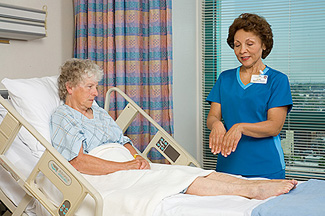
Fig 1A: Calf pumping. Point toes.
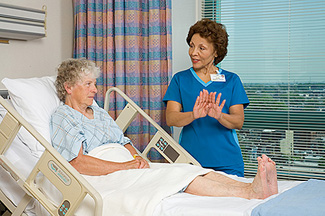
Fig 1B: Calf pumping. Relax and pull toes toward chin.
-
Make circles with both ankles in one direction, then the other. An alternative is to have the client perform the exercise with one ankle at a time (Fig 2).
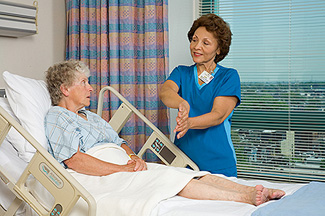
Fig 2: Calf pumping. Ankle circles.
-
Point the toes of both feet toward the end of the bed, relax, then pull toes toward the chin (Fig 1A and B).
-
Knee flexion and extension
-
Start with knees in a flexed position, with feet flat on the bed. Slide the feet forward as far as possible (Fig 3A).
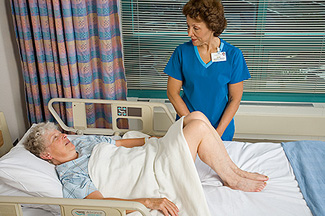
Fig 3A: Knee flexion.
-
Slide feet back to repeat flexed position (Fig 3B).
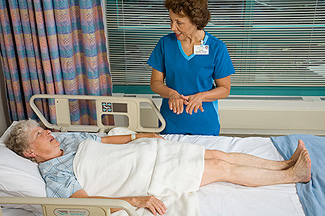
Fig 3B: Knee extension.
-
Start with knees in a flexed position, with feet flat on the bed. Slide the feet forward as far as possible (Fig 3A).
-
Raising and lowering leg
-
Start with legs flat on the bed, with feet flexed. Raise and lower each leg alternately (Fig 4).
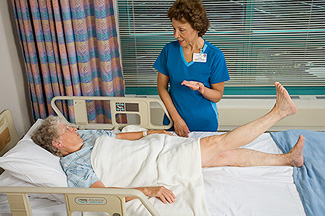
Fig 4: Raise and lower each leg.
- Raise as far as comfort allows without straining.
-
Start with legs flat on the bed, with feet flexed. Raise and lower each leg alternately (Fig 4).
-
Calf pumping
-
While the client is performing the exercises, assess the client for signs of exertion or discomfort while performing the exercises.
Rationale: Assessment alerts nurse if exercise activity needs to be stopped.
-
At the completion of the exercises, assist the client to a position of comfort and replace the covers.
Rationale: Repositioning promotes comfort.
-
Assess vital signs.
Rationale: Assessment provides follow-up data regarding effects of exercise on client.
-
Return the bed to a low position, ensure the wheels are locked, and apply an appropriate amount of side rails.
Rationale: Repositioning bed promotes client safety and prevents falls.
-
Place the call light within reach.
Rationale: Call light facilitates communication.
- If necessary, remove your gloves.
-
Wash your hands.
Rationale: Handwashing reduces transfer of microorganisms.
- Document the exercises performed, the number of repetitions, reports of pain or discomfort, and any observations of physiologic intolerance to the activity.
| Sample Documentation | ||
| 10/12/08 | 1000 |
Calf pumping, knee flexion, and extension exercises performed. Client performed 2 sets of 10 exercises. Client reported no pain or discomfort during exercises. No signs of activity intolerance noted. Vital signs taken after exercises, see flow sheet. Natalie Conway, RN |
Lifespan Considerations
Infant/Child- For a child, demonstrate the exercises on a doll first.
- Observe elderly clients with chronic conditions closely for respiratory difficulty, chest pain, and general discomfort. Decreased muscle mass, degenerative changes in joints, and degenerative tissue changes can result in limited range of motion.